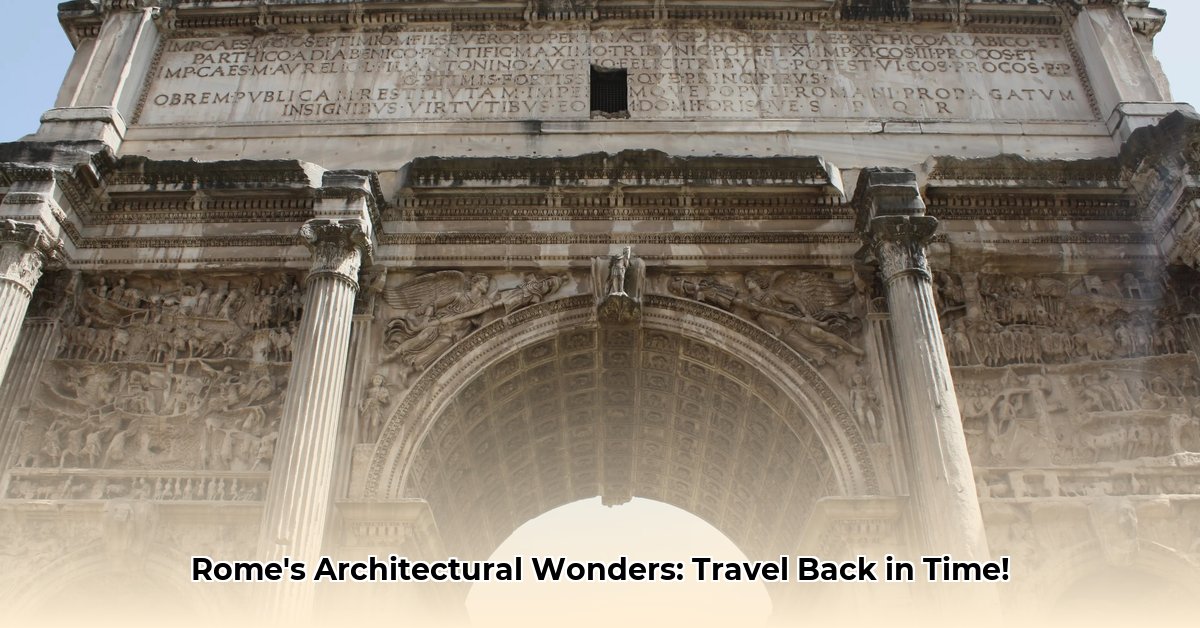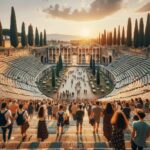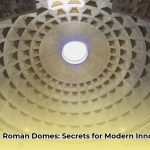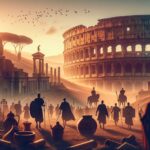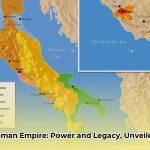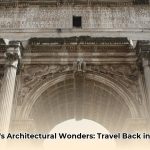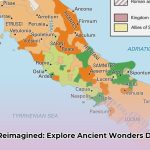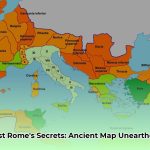Have you ever walked through Rome and felt the weight of history in its ancient stones, wondering how masterpieces from thousands of years ago still stand firm against the relentless march of time? This article offers an in-depth exploration of the most remarkable structures the ancient Romans built, delving into the extraordinary engineering prowess and architectural innovation that allowed them to endure for millennia. Learn more about their impressive achievements, like these ancient Roman domes. From the iconic Colosseum, a testament to their mastery of grand spectacle, to the sophisticated aqueduct systems that transformed daily life, we will uncover the genius behind these architectural wonders. We will investigate the revolutionary properties of Roman concrete, explore the challenges and triumphs of historical preservation, and observe how Roman engineering continues to influence contemporary building designs globally. Prepare to discover the unique and lasting qualities of a civilization that reshaped the built world.
The Foundational Pillars of Roman Architectural Ingenuity
The Romans were not merely builders; they were visionary innovators who revolutionized construction. Their lasting legacy stems from a profound understanding of materials, an audacious approach to structural design, and an unparalleled commitment to public infrastructure.
Roman Concrete: The Unsung Hero of Longevity
Unlike the Greeks, who primarily relied on cut stone blocks, the Romans embraced concrete, known as opus caementicium. This wasn’t the concrete we use today; it was a miraculous blend of lime, volcanic ash (pozzolana), water, and aggregate (such as crushed rocks or brick). The pozzolana reacted chemically with the lime and water, creating a highly durable, water-resistant material that actually strengthened over time, especially when exposed to seawater. This innovation allowed them to pour massive, complex shapes, reduce construction time, and build structures of unprecedented scale and resilience previously deemed impossible. Its flexibility and strength were key to developing vast, load-bearing structures.
Mastering Arches, Vaults, and Domes
Beyond concrete, the Romans perfected the use of arches, vaults, and domes, structural elements that allowed them to span greater distances and enclose vast spaces without relying on numerous internal supports. The arch efficiently distributes weight outwards and downwards, while barrel vaults (extended arches) and groin vaults (two intersecting barrel vaults) enabled the creation of large, open interiors. The dome, a crowning achievement, provided magnificent, soaring ceilings. These techniques were not just aesthetically grand but were fundamentally practical, minimizing material use while maximizing structural integrity and interior space.
The Lifeline of an Empire: Advanced Water Management
Roman civilization thrived on its sophisticated water systems. Aqueducts, some stretching for tens of miles across varied terrain, employed a precise system of gravity, arches, and subterranean channels to transport millions of gallons of fresh water daily into cities. This water supplied public fountains, private homes, and, most notably, the grand public baths. These baths were not just for hygiene; they were social, cultural, and athletic centers, often featuring complex heating systems (hypocausts) and intricate plumbing, showcasing advanced hydraulic engineering.
Iconic Marvels of Rome: Enduring Symbols of Grandeur
The Eternal City itself is an open-air museum of Roman architectural genius, with structures that continue to captivate and educate visitors from around the globe.
The Colosseum: Amphitheater of Spectacle
Also known as the Flavian Amphitheater, the Colosseum stands as the largest amphitheater ever built, a monumental symbol of Rome’s power and influence. Constructed between 70 and 82 CE under Emperors Vespasian and Titus, it could host an astounding 50,000 to 80,000 spectators for gladiatorial contests, animal hunts, and public spectacles. Its elliptical design, measuring 188 meters long and 156 meters wide, showcased a complex system of arches, vaults, and concrete, enabling rapid crowd movement through 80 entrances. The Colosseum’s intricate underground passages, or hypogeum, housed gladiators, animals, and scenery, which could be lifted to the arena floor by elevators and trapdoors, demonstrating sophisticated mechanical engineering. Its partial preservation, despite centuries of earthquakes and stone quarrying, speaks volumes about its original construction quality.
The Pantheon: A Dome of Divine Proportion
The Pantheon, built by Emperor Hadrian around 126 CE on the site of an earlier temple by Marcus Agrippa, is arguably the best-preserved ancient Roman building and a marvel of engineering. Its most striking feature is its massive unreinforced concrete dome, still the largest of its kind in the world, with a diameter of 43.3 meters (142 feet). This monumental dome incorporates a unique blend of increasingly lighter aggregates towards its apex, reducing its weight, and culminates in a central opening, the “oculus,” which serves as the sole source of natural light and a symbolic connection to the heavens. Originally a temple dedicated to all gods, its transformation into a church in the 7th century, Santa Maria ad Martyres, played a crucial role in its exceptional preservation, inspiring countless domes throughout architectural history, including Michelangelo’s design for St. Peter’s Basilica.
The Roman Forum: Heart of an Empire
The Roman Forum, nestled in a valley between the Palatine and Capitoline Hills, was the pulsating heart of ancient Rome. Far from being a single building, it was a sprawling complex of temples, basilicas, government buildings, and markets that evolved over centuries. It served as the city’s primary marketplace, religious center, and a vibrant stage for public speeches, criminal trials, and triumphal processions. Key structures like the Temple of Saturn, the Basilica Julia, and the Curia Julia (where the Senate met) testify to its central role in Roman civic life. Though largely in ruins today due to centuries of neglect and repurposing, extensive excavations continue to reveal layers of history, offering unparalleled insights into the daily lives, political intrigues, and religious practices of the ancient Romans.
The Baths of Caracalla: Grandeur of Public Life
Completed around 216 CE under Emperor Caracalla, the Baths of Caracalla were one of Rome’s most ambitious public works, exemplifying the Roman commitment to public welfare and luxury. This immense complex was more than just a bathing facility; it was a sprawling recreational and cultural center accommodating up to 1,600 bathers at a time. It featured a caldarium (hot bath), frigidarium (cold bath), tepidarium (warm bath), natatio (swimming pool), gymnasiums, libraries, and gardens. The engineering behind its heating system (hypocausts, which circulated hot air under floors and through walls) and water supply (fed by dedicated aqueducts) was incredibly advanced. Though largely in ruins, its magnificent scale, surviving mosaics, and structural ingenuity still convey the opulence and sophistication of Roman public life.
Castel Sant’Angelo: From Mausoleum to Fortress
Originally built as a mausoleum for Emperor Hadrian and his family between 123 and 139 CE, Castel Sant’Angelo evolved significantly over its long history, becoming a military fortress, a papal residence, and even a prison. Its imposing cylindrical shape, massive walls, and strategic location on the banks of the Tiber River made it an essential part of Rome’s defenses, connected directly to Vatican City by the Passetto di Borgo, a fortified elevated passageway used by popes in times of danger. This transformation from a tomb to a stronghold perfectly illustrates the adaptability and enduring utility of Roman construction, with its complex interior revealing centuries of the city’s turbulent history.
The Aqueducts of Rome: Veins of the City
While specific individual aqueducts within Rome, such as Aqua Claudia or Aqua Appia, are often highlighted, the collective system of eleven ancient Roman aqueducts that supplied the city was an engineering masterpiece. These structures, often running for miles underground and then emerging as monumental arched bridges, ensured a constant, clean water supply, sustaining Rome’s massive population and its many public amenities. The visible ruins, particularly in the Parco degli Acquedotti, showcase the Romans’ advanced surveying and construction techniques, proving their ability to manipulate natural gradients to deliver water efficiently across vast distances.
The Empire’s Lasting Imprint: Roman Structures Beyond Rome
The reach of Roman engineering and architecture extended far beyond the Italian peninsula, leaving indelible marks across Europe, Africa, and the Middle East, demonstrating a consistent application of their innovative techniques.
Pont du Gard: A Masterpiece of Dry Masonry
Located in southern France, the Pont du Gard is perhaps the most impressive surviving segment of a Roman aqueduct. Built in the 1st century CE, this three-tiered bridge stands 49 meters (160 feet) high and spans 275 meters (902 feet) across the Gardon river. What makes it truly astonishing is that it was constructed almost entirely without mortar. Roman engineers precision-cut massive stone blocks, some weighing up to six tons, and fitted them together with incredible accuracy, relying on gravity and their advanced understanding of mechanics to create a structure that has stood for over 2,000 years. It supplied water to the city of Nîmes, showcasing perfect gradient control over its 50-kilometer (31-mile) length.
Aqueduct of Segovia: Enduring Urban Lifeline
In Segovia, Spain, stands another exceptionally well-preserved Roman aqueduct, a testament to Roman engineering ingenuity outside Italy. Built around 50 CE, this colossal structure, over 16 kilometers (10 miles) long, brought water from the Frio River to the city. Its most striking section is a double-tiered arcade with 165 arches, reaching heights of 28.5 meters (93 feet) in the Plaza del Azoguejo. Like the Pont du Gard, it was constructed using dry masonry, with massive granite blocks perfectly balanced without the use of mortar, demonstrating the widespread application of advanced Roman construction techniques across the empire. It served as the primary water supply for Segovia for nearly two millennia, a true symbol of Roman efficiency.
Diocletian’s Palace: A Fortress City
Built between 295 and 305 CE in Split, Croatia, Diocletian’s Palace was not merely a palace but a sprawling fortified complex designed for Emperor Diocletian’s retirement. Covering an area of approximately 30,000 square meters, it combines features of a luxurious villa, a military camp, and a fortified town. Its massive walls, up to 2 meters thick, and four gates protected imperial apartments, military barracks, temples, and a mausoleum. The palace’s unique blend of architectural styles, incorporating ancient Roman, Greek, and early Byzantine influences, and its remarkable state of preservation (it forms much of Split’s current city center) offer a vivid glimpse into late Roman imperial architecture and urban planning.
Hadrian’s Villa: An Emperor’s Architectural Vision
Located near Tivoli, Italy, Hadrian’s Villa was a vast, sprawling retreat built by Emperor Hadrian in the 2nd century CE. More a miniature city than a simple villa, it encompassed palaces, baths, theaters, temples, and gardens spread over 120 hectares, reflecting Hadrian’s extensive travels and his love for Greek and Egyptian cultures. The complex showcases innovative architectural experimentation, blending traditional Roman forms with exotic influences. Features like the Canopus, a long pool inspired by an Egyptian canal, and the Maritime Theater, a circular island surrounded by a moat, highlight Hadrian’s personal architectural vision and the empire’s cosmopolitan reach in design and leisure.
Baalbek: Temples of Gigantic Proportions
In modern-day Lebanon, the archaeological site of Baalbek hosts some of the largest and most awe-inspiring Roman temple ruins in the world. Dating primarily from the 1st to 3rd centuries CE, the complex includes the immense Temple of Jupiter and the remarkably well-preserved Temple of Bacchus. The scale of these structures is staggering; the Temple of Jupiter, for example, once featured 54 colossal granite columns, each 21 meters (70 feet) tall, and rests on a platform containing some of the largest cut stones in the world. Baalbek exemplifies the Roman imperial practice of constructing monumental sacred spaces in conquered territories, adapting local traditions to Roman grandeur and showcasing the immense resources and ambition of the empire’s architectural endeavors.
The Enduring Legacy: Roman Influence and Modern Preservation
The innovations of Roman architecture and engineering did not end with the fall of the Western Roman Empire. Their principles and aesthetics continued to inspire countless generations of builders and designers, shaping the architectural landscape of the Renaissance, Neoclassical periods, and even modernism. The sheer durability of Roman concrete and the logical efficiency of arches and vaults laid the groundwork for future structural advancements.
Today, the preservation of these ancient wonders presents both opportunities and challenges. Sites like the Colosseum and the Roman Forum require continuous conservation efforts to protect them from environmental decay and the impact of millions of visitors. However, the study of their construction provides invaluable insights into ancient technologies and materials, informing restoration techniques and even inspiring new sustainable building practices. Modern Roman buildings, like Zaha Hadid’s MAXXI Museum, while futuristic, still echo the Roman spirit of innovation and daring structural expression. Even the Palazzo della Civiltà Italiana, known as the “Square Colosseum,” built during the Fascist era, overtly references the ancient amphitheater in its design, showcasing a historical continuity in architectural thought.
The ancient Roman buildings we admire today are more than just ruins; they are enduring monuments to an empire’s visionary engineering prowess and its profound impact on human civilization. They serve as a powerful reminder that truly great architectural wonders are built not just for their time, but for eternity.
- Unearth ancient rome roads: Empire’s power and modern highway’s origin - August 15, 2025
- Discover geography of ancient Rome: Empire’s secrets revealed (2024 insights) - August 15, 2025
- Unveiling Ancient Roman Empire Geography: Power & Legacy Secrets - August 15, 2025
